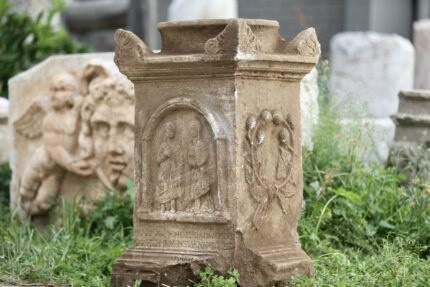Imperial Roman necropolis found during railroad construction

A Roman Imperial era necropolis has been unearthed during railway construction in Sicily. The large burial ground contains 168 graves in a wide diversity of styles attesting to the complex social strata of the associated Roman settlement.
 Italferr, the engineering firm of the Italian State Railways, has an in-house staff of archaeologists who are involved from the earliest planning stages in all railway projects. The current project, a new direct route connecting Palermo to Catania, runs through the Dittaino River valley, a strategically significant territory for the ancient Greek colonies of Sicily, the Punic outposts and later for the Romans. Italferr’s archaeologists unearthed a large settlement dating to the early Roman Imperial period (1st century-3rd century A.D.) on a hill overlooking the valley. West of the settlement on the hilltop and northwest slope, the team discovered the necropolis.
Italferr, the engineering firm of the Italian State Railways, has an in-house staff of archaeologists who are involved from the earliest planning stages in all railway projects. The current project, a new direct route connecting Palermo to Catania, runs through the Dittaino River valley, a strategically significant territory for the ancient Greek colonies of Sicily, the Punic outposts and later for the Romans. Italferr’s archaeologists unearthed a large settlement dating to the early Roman Imperial period (1st century-3rd century A.D.) on a hill overlooking the valley. West of the settlement on the hilltop and northwest slope, the team discovered the necropolis.
 The burials reflect a highly stratified society, with monumental tombs and pit burials with angled roofs made of tiles. One tomb in particular, a bustum, or mound grave, contained a rich group of objects: five necklaces, two gold rings and a cinerary urn in prized white Carrara marble inscribed with a dedication to the Magnus Magister Pecoris, the top administrator in charge of management and breeding of the sheep flocks. The inscription also refers to a dispensator, the administrator who gave the urn to the deceased.
The burials reflect a highly stratified society, with monumental tombs and pit burials with angled roofs made of tiles. One tomb in particular, a bustum, or mound grave, contained a rich group of objects: five necklaces, two gold rings and a cinerary urn in prized white Carrara marble inscribed with a dedication to the Magnus Magister Pecoris, the top administrator in charge of management and breeding of the sheep flocks. The inscription also refers to a dispensator, the administrator who gave the urn to the deceased.
 The settlement appears to have been centered around a villa rustica (a country estate with agricultural functions), but architectural remains of floors and collapsed roofs confirm that the full settlement covered the entire slope. The structures were not residential dwellings, however. They were outbuildings dedicated to the production aspects of the villa.
The settlement appears to have been centered around a villa rustica (a country estate with agricultural functions), but architectural remains of floors and collapsed roofs confirm that the full settlement covered the entire slope. The structures were not residential dwellings, however. They were outbuildings dedicated to the production aspects of the villa.
 East of the necropolis, archaeologists did magnetometric surveys, discovering what appears to be an area of cult use. It is a channel with fragments of burned animal bones alternating with layers of alluvial deposits. This suggests cult rites were performed in this area of the site. Artifacts found in this area include oscilla, small masks or circular plates that were hung on tree branches as offerings to the gods, and needles or pins carved out of bone.
East of the necropolis, archaeologists did magnetometric surveys, discovering what appears to be an area of cult use. It is a channel with fragments of burned animal bones alternating with layers of alluvial deposits. This suggests cult rites were performed in this area of the site. Artifacts found in this area include oscilla, small masks or circular plates that were hung on tree branches as offerings to the gods, and needles or pins carved out of bone.
Excavations are ongoing with the ultimate goal of documenting the entirety of the archaeological remains of the settlement and necropolis.


 Anal Beads
Anal Beads Anal Vibrators
Anal Vibrators Butt Plugs
Butt Plugs Prostate Massagers
Prostate Massagers
 Alien Dildos
Alien Dildos Realistic Dildos
Realistic Dildos
 Kegel Exercisers & Balls
Kegel Exercisers & Balls Classic Vibrating Eggs
Classic Vibrating Eggs Remote Vibrating Eggs
Remote Vibrating Eggs Vibrating Bullets
Vibrating Bullets
 Bullet Vibrators
Bullet Vibrators Classic Vibrators
Classic Vibrators Clitoral Vibrators
Clitoral Vibrators G-Spot Vibrators
G-Spot Vibrators Massage Wand Vibrators
Massage Wand Vibrators Rabbit Vibrators
Rabbit Vibrators Remote Vibrators
Remote Vibrators
 Pocket Stroker & Pussy Masturbators
Pocket Stroker & Pussy Masturbators Vibrating Masturbators
Vibrating Masturbators
 Cock Rings
Cock Rings Penis Pumps
Penis Pumps
 Wearable Vibrators
Wearable Vibrators Blindfolds, Masks & Gags
Blindfolds, Masks & Gags Bondage Kits
Bondage Kits Bondage Wear & Fetish Clothing
Bondage Wear & Fetish Clothing Restraints & Handcuffs
Restraints & Handcuffs Sex Swings
Sex Swings Ticklers, Paddles & Whips
Ticklers, Paddles & Whips


















